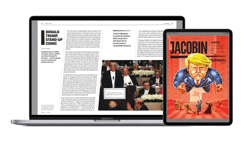If yours is a consumer-focused magazine, Facebook is one of the top social portals used by magazines. B2B magazines make a splash, too, but general audience magazines always have larger audiences than niche magazines on Facebook. People Magazine has over 6.4 million fans while Entrepreneur has 2.9 million. More people like reading about celebrities than starting businesses, I suppose. Not you, though!
If you're starting a new magazine, spend resources on the social networks that work best for your content. If yours is a consumer magazine, Facebook may ultimately become your number-one traffic generator. Unfortunately for all businesses, especially new ones, Facebook limits the visibility of all your posts, so you may need to get creative to get engagement shares that further your reach. Still, the potential on Facebook is tremendous. Here are my nine steps:
1. Create a Facebook page
It might seem like there's a blank page you'll need to populate, and that's exactly right. Your page will become a canvas you will populate with images, quotes, questions and stories. And it should always look exactly how you want a new visitor to see it. You might not be publishing articles on your magazine portal just yet because your site hasn't launched yet, but you can still post sneak peeks to tease readers on Facebook. Share photos from interviews and photo shoots (and continue to do this for every issue). Share insider bits about the launch, too. People will feel more connected to your brand if they get to see how each issue is compiled and curated behind the scenes.
2. Promote your new magazine before you launch
Create paid promotions that will attract new likers to your page so that when the page launches, the promotions will be ready to go. Facebook's ad platform is easy to use and gives you the ability to target only the right people. If you're launching a regional magazine, you can micro-target ads to a town or macro-target them to a country. You can even target individuals by job description and interest. You'll spend less on ads and eventually have higher engagement if you start your page with the right ‘likes’.
Inviting all your friends and family and all their friends and family to like your page when they may have no interest in the topic is going to harm your page visibility.
The more likes, comments, clicks, and shares your posts get, the more reach they'll have. Facebook determines this on a ratio, so having a slew of fake likes, bought likes, or likes from family and friends will hurt your ratio and ultimately hurt you in the long run.
3. Give something away
Promote a free download that will not only get people to your page but will also convert them to email subscribers. While Facebook may limit the visibility of your posts, you have 100% visibility on your email list. When it's time to subscribe, you can send out a promotional email, and all eyes will be on you. When you promote on Facebook, you might receive 10% feedback or less, depending on how active you've been on Facebook leading up to the launch. Remember, more active is not better. It's more engagement that matters. If you don't get a lot of engagement, post less, not more.
Once your magazine launches, this is when it gets exciting. You'll want to develop something like an editorial calendar for your social efforts.
4. Create a Facebook style guide
Decide who will be writing your Facebook posts. Will you have an editor on hand who will be responsible, or will you have a social media strategist? Will you tag other businesses in your posts, and will those be competitors for the sake of sharing a story, or will everything either be internal or for an advertiser? Will you respond to negative comments, or will you block them? Will you use one or multiple images in your link posts? What will be the overall tone of your posts?
Try to think about all the types of content you will be producing and how your team might handle them in any situation. Your Facebook style sheet will always be a work in progress, but a solid foundation will lead to less confusion in the future.
5. Establish KPIs
While you grow, any growth is good growth. Once you start to settle in and plateau, you'll want to have Key Performance Indicators (KPIs) handy that tell you how you're doing. If you were growing at a rate of 7% last month, then maybe your goal is 8% this month. If you had 232 likes last month, shoot for 250 likes this month. When you first launch, you'll most likely be seeing all growth at a rapid rate, but once you come down from the high, decide what factors you see as success.
Common Facebook KPIs include fan growth, increases in engagement, increases in clicks (especially important for improving visibility), reach, engagement by content type (links, images, video, etc), conversions (for your freebies, subscriptions, etc), and negative comments. You can't control negative nancies behind a keyboard, but if you're in a niche that attracts those types, you should keep tabs on it because it could influence how new visitors see you.
6. Create Facebook formulas
So you're ready to get started posting? Not so fast. It might seem like social media is flippant and you can come up with whatever seems catchy at the time, but your social efforts should come from a place of research.
Come up with five to ten Facebook post formulas that you plan to recycle. As you get engagement, likes, etc you will learn which formulas work best, and you can continue to tweak those recipes until your team comes up with posts that win every single time. That's the beauty of starting fresh, although any magazine can do it at any point in its life. Some formula ideas for sharing magazine articles could include:
* Posting the link to an article with several images
* Posting the link to an article with just one image
* Using the description to ask a question that calls for comment
* Using the description with a hashtag that could bring in new readers
* Using the description to get the reader to click
* Using the description to get the readers to share the post
For those in-between posts, consider how you'll get likes and shares on non-editorial posts in-between to keep your page visibility up.
* Create graphics of your favourite industry-specific quotes
* Come up with a series of fill-in-the-blank statements readers can fill in
* Use trivia questions with eye-catching graphics to get comments
* Create contests that include sharing the page and getting likes
* Start an AMA on Facebook, and let fans ask you anything
* Post behind-the-scenes photos of interviews and photo shoots
* Post about one of your staff and how much they contribute to the team (sort of like an employee-of-the-month revolving theme)
7. Create a social media calendar
Typically, most publishers will post new content every day, throughout the day, whenever it publishes. Spread it out so that all of your social media posts do not end at 9 am, leaving a huge gap in the rest of the day. Also, make room for several promotions throughout the week for the magazine. They can be as subtle as those behind-your-interview shots promoting the new issue, or as bold as "save 80% off the cover price but only if you buy today!" Make room also for at least one ‘fun’ post (described above) every day.
8. Decide how you'll handle content behind the wall
Hopefully, your new magazine strategy doesn't involve giving away all your premium magazine content on your free portal. Don Nicholas, founder and chairman of Mequoda, a consultancy for niche magazine publishers, says that every magazine publisher should have at least two subscription websites. The first one is your free portal where you give away your free content and collect subscribers to your email list. The second is your magazine subscription website, where you collect magazine subscribers and the users can log in to read digital issues of your magazine.
Having this digital portal of premium content behind the wall means you have a hyperlink to promote each article. That means your content doesn't need to be hidden from non-subscribing muggles; you can bring light to premium content on Facebook by promoting it just like a free article. So that you don't annoy non-subscribers, you may want to hold off on daily promotion, but picking one post per week that you love and explaining that it's a special piece for subscribers could very well turn likers into subscribers.
9. Decide on an advertising strategy
Will you accept advertising on your Facebook page? One of the biggest new trends is to allow advertisers access to your social media accounts. Sometimes, posts are included in bundled print / web ad packages, but there's one outlier you might not have considered: native ads. You can promote native ads on your social media pages just like articles, but you'll be providing a huge benefit to your fans instead of quick posts promoting a product with a link.
Remember, according to the Internet Advertising Bureau (IAB UK), native advertisements, even when shared in social media, must "provide consumers with prominently visible visual cues enabling them to immediately understand they are engaging with marketing content compiled by a third party in a native ad format which isn’t editorially independent (eg. brand logos or design, such as fonts or shading, clearly differentiating it from surrounding editorial content)." They add that it "must be labelled using wording that demonstrates a commercial arrangement is in place (eg. ‘paid promotion’ or ‘brought to you by’)."
How to get started marketing your magazine on Facebook
My best advice is to create the structure provided above before you do anything. Scratch that; you should try and land a good Facebook page and Facebook URL as soon as you've come up with the name of your publication.
After that, and before you begin promoting your page, treat it like a canvas for what new visitors to the page will see once you start pushing it. Make it a spread of thoughtful insight, colourful imagery, and behind-the-scenes looks at the making of a new magazine. You could even begin posting letters from the editor every week, updating potential subscribers about the stage of launch you're in. Readers, especially millennials, love to feel that they're part of something. You have a golden hour of opportunity before launch to tweak the magazine to be exactly what people want, and not what you think they want. Use Facebook to gather opinions and ideas. If you do it right, you could easily create a vibrant, active, and engaging audience well before your magazine launches.












